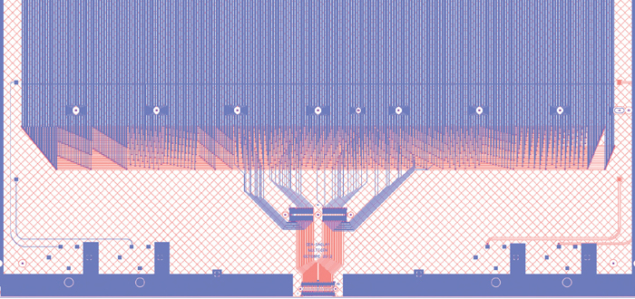
Image credit: CEA-Saclay.
Modern physics experiments often require the detection of particles over large areas with excellent spatial resolution. This inevitably leads to systems equipped with thousands, if not millions, of read-out elements (strips, pixels) and consequently the same number of electronic channels. In most cases, it increases the total cost of a project significantly and can even be prohibitive for some applications.
In general, the size of the electronics can be reduced considerably by connecting several read-out elements to a single channel through an appropriate multiplexing pattern. However any grouping implies a certain loss of information and this means that ambiguities can occur. Sébastien Procureur, Raphaël Dupré and Stéphan Aune at CEA Saclay and IPN Orsay have devised a method of multiplexing that overcomes this problem. Starting from the assumption that a particle leaves a signal on at least two neighbouring elements, they built a pattern in which the loss of information coincides exactly with this redundancy of the signal, therefore minimizing the ambiguities of localization. In this pattern, two given channels are connected to several strips in such a way that these strips are consecutive only once in the whole detector. The team has called this pattern “genetic multiplexing” for its analogy with DNA, as a sequence of channels uniquely codes the particle’s position.
Combinatorial considerations indicate that, using a prime number p of channels, a detector can be equipped with at most p(p–1)/2+1 read-out strips. Furthermore, the degree of multiplexing can be adapted easily to the incident flux. Simulations show that a reduction in the electronics by a factor of two can still be achieved at rates up to the order of 10 kHz/cm2.
The team has successfully built and tested a large, 50 × 50 cm2 Micromegas (micro-pattern gaseous detector) with such a pattern, the 1024 strips being read out with only 61 channels. The prototype showed the same spatial resolution as a non-multiplexed detector (Procureur et al. 2013). A second prototype that is built from resistive-strip technology will be tested soon, to achieve efficiencies close to 100%.
The possibility of building large micro-pattern detectors with up to 30 times less electronics opens the door for new applications both within and beyond particle physics. In muon tomography, this multiplexing could be used to image large objects with an unprecedented accuracy, either by deflection (containers, trucks, manufacturing products) or by absorption (geological structures such as volcanoes, large monuments such as a cathedral roof). The reduction of the electronics and power consumption also suggests applications in medical imaging or dosimetry, where light, portable systems are required. Meanwhile, in particle physics this multiplexing could bring a significant reduction in the cost of electronics – after optimizing the number of channels with the incident flux – and simplifications in integration and cooling.
Further reading
S Procureur, R Dupré and S Aune 2013 Nucl. Instrum. & Meth. A. 729 888.





